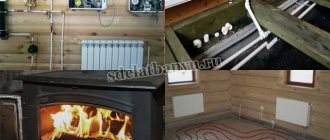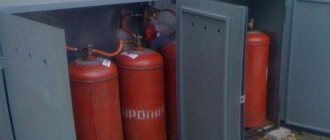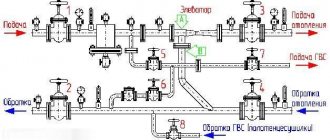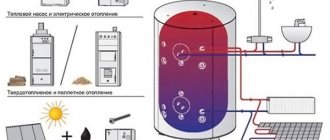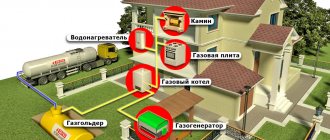You are the owner of a country house where main gas is not supplied, and the electrical networks are not designed for heavy loads, hence the allocated limit of 5 kW for all needs. Another variation on the theme: you are a rural resident of Ukraine, where the cost of blue fuel has jumped to 7.2 UAH. (0.3 USD) per 1 m³, so you cannot use it due to low income. There are other, more complex situations.
In this situation, you are faced with the task of providing heating for a private house without gas and electricity, preferably economically. Let's identify alternative heating methods and look at all the nuances associated with their implementation.
How to heat a house without gas
Other heating options without gas:
- Electric Energy . The simplest organizational alternative to gas heating in a private home is electricity. Currently, there is practically not a single corner of our country where electrification has not yet been carried out. On the other hand, maintaining electric boilers and heaters will be quite expensive.
- Diesel fuel . It is used both in mobile heating devices and in boilers. Although the cost of diesel fuel is small, quite a lot of it will be required to maintain the constant operation of the boiler equipment. In addition, you should take into account the specific strong smell that accompanies the operation of diesel heaters.
- Coal . An excellent option for heating a private home without gas for regions where this fuel is directly available. A simple arithmetic calculation of the financial costs of heating a house using coal shows that this will require 4 times less money than in the case of diesel fuel.
- Peat . Another way to obtain heat without gas. It goes on sale in the form of pressed briquettes.
- Firewood . Perfect for areas where firewood is freely available. In other situations, this option, how to heat a house without gas, is quite problematic due to the rapid consumption of heating material. In this case, it is much more convenient to use pellets (pellets from wood processing waste). Pellet boilers, as a rule, are equipped with special automation that independently loads fuel.
Coal and firewood act as the main type of fuel for stoves and fireplace equipment: it is the most optimal option for heating a house when there is not only gas, but also electricity. You can build a stove or fireplace yourself, from refractory bricks, or purchase it ready-made. Store models are made of steel or cast iron and have significant decorative qualities. In addition to directly heating the home, appliances of this type allow you to cook food on them: especially for this purpose, their design includes an oven and a hob.
Heating with coal
Coal heating is another option if your home doesn't have gas. But there is one significant difference between heating with wood and heating with coal: if when heating with wood, the room is heated immediately from the flame, then when using coal, the room is heated by the coolant.
Modern boilers also use the principle of top combustion, which is achieved due to the fact that air is supplied from the top of the device thanks to a fan. Due to this, the fuel burns slowly, due to which the time between fuel loads increases significantly. The design of modern coal-fired boilers includes a firebox, an ash pan, a heat exchanger, and a chimney pipe.
- Brown coal. This type burns at low temperatures, but is currently being pushed out of the market by other brands.
- Stone. This brand burns with a long flame, so it is widely used for heating.
- DPKA. This coal is widely used for heating small private houses.
- Anthracite. According to experts, this grade of coal is the highest quality coal. This charcoal has a brilliant black color. The carbon content reaches 90%.
You can buy coal in bags, or you can order a certain amount for delivery.
Below are the pros and cons of coal heating.
So, the pros:
- The versatility of the boiler. A coal boiler can be used not only for heating with coal. You can also put firewood, briquettes and other types of solid fuel in it.
- High heat dissipation.
- Long burning.
There are also disadvantages:
- Coal dust. When using coal as the main fuel, coal dust remains everywhere, which requires cleaning.
- Cleaning the ash pit. When coal burns, a lot of ash remains, so the ash pan will have to be cleaned periodically.
Autonomous sources of electricity
When deciding what is the best way to heat a house if there is no gas, some owners of private households use original technical solutions.
The most economical heating of a private house without gas is to use autonomous sources of electrical energy:
- Solar energy . To convert solar energy into electrical energy, you will need special solar collectors. This will allow the use of an autonomous heater that does not depend on mains electricity. The main thing in this case is to find finance to purchase the necessary equipment. In the future, electrical energy will be supplied to the home practically free of charge.
- Wind energy . It can also be converted into heat to heat your home without gas. This happens inside a special unit that converts mechanical energy into electrical energy. Some craftsmen assemble such structures with their own hands. This is not so difficult to do, since the converter includes only three parts - a windmill, a battery and a generator. All that is required is to correctly connect these devices to each other. It is especially beneficial to use wind power generators in uninhabited, well-ventilated areas located away from gas fields. If you have not yet decided how to heat your house if there is no gas, it is worth considering this option.
Air conditioners
Air conditioning is the most affordable and simplest alternative source of home heating. You can install one powerful one on the entire floor or one in each room.
The best option for using an air conditioner is in late spring or early autumn, when it is not too cold outside and you don’t have to start the gas boiler yet. This will reduce gas consumption due to electricity and not exceed the monthly gas consumption rate.
Important points:
- The boiler and air conditioner must be linked to each other to work as a pair. That is, the boiler must see that the air conditioner is working and not start working while the room is warm. A wall thermostat is indispensable here.
- Heating with electricity is not cheaper than gas. Therefore, you should not completely switch to heating with air conditioners.
- Not all air conditioners can be used in freezing temperatures.
When there is no boiler and pipes
Most often, the center of the heating system is the boiler, in which the coolant is heated: it is transported to radiators installed in different rooms via a pipeline. In country houses and cottages, you don’t have to use the boiler at all, replacing it with a stove or fireplace.
An example of such an option for heating a country house without gas is the old Russian house design - a five-wall house. The stove is located in the center, serving as a separator between two adjacent rooms.
Classic stove heating
In certain cases, a stove is the only possible way to organize heat in the house
Stove heating is considered the oldest. Stove heating is still often used in suburban buildings. Don't think that this method is outdated. The lack of gas in some regions leaves this type of heating still very popular and in demand. Combination stoves remain in fashion, allowing both heating a room and cooking food. Among the advantages of this option are savings on installation, operation, fuel, and versatility. With all this, stoves need to be heated several times a day; they require constant maintenance. In addition, the risk of fire is high; ovens are quite large and take up a lot of space. The room in which the stove is located is always contaminated with soot and coal, and will also require constant cleaning and regular maintenance. There is a high risk of carbon monoxide poisoning if the stove is used incorrectly.
Heat pump
When solving the problem of how to heat a house without gas, they sometimes resort to a very unusual method that does not require any fuel.
We are talking about a heat pump consisting of the following elements:
- Tubes filled with freon.
- Heat exchanger.
- Throttle chamber.
- Compressor.
The operation of the device is based on the principle of operation of a refrigerator. Tubes with freon inside are lowered into the ground or the nearest body of water: as a rule, this environment, even in winter, never cools below +8 degrees. Considering the fact that freon boils at a temperature of +3 degrees, this is quite enough for the substance to constantly be in a gaseous state. Rising upward, the gas enters the compressor, where it undergoes significant compression. Any substance in such conditions sharply increases its temperature: in the case of freon, it heats up to +80 degrees.
The energy thus released is used through a heat exchanger to heat the coolant in the heating system. The final cooling of freon (as well as a decrease in its pressure) occurs in the throttle chamber, after which it passes into a liquid state. Then the cycle is repeated - the liquid is sent through pipes deep into the earth or reservoir, where it is heated again. For the functioning of this scheme for generating heat for the home, electrical energy will also be required: its consumption here is much less than when using electric boilers or heaters.
Metal furnaces
Once upon a time they were called potbelly stoves. This name dates back to the distant times of the civil war and subsequent devastation, when the simplest joys of life were associated with great wealth.
Much has changed since then, but an iron stove is still called a potbelly stove. They look different now. Many of them are equipped with fireproof glass windows, but their essence has not changed - they heat up quickly and cool down just as quickly.
Maybe that’s why this stove was called a potbelly stove, because maintaining a constantly high temperature requires a lot of wood, bourgeois style.
Folk fantasy
In the Siberian taiga huts, where it is possible to install a cast-iron stove, but it is difficult to deliver bricks, the potbelly stove is lined on three sides with large stones, rolled in by the river. It turns out beautiful and functional - the stones heat up and slowly release heat to the air.
This technique is quite applicable in the conditions of a country house - when the house is built, but the heating is not yet ready. To some extent, stones perform fire-fighting functions, absorbing random sparks and excess heat. Stone structures can serve as a reason for the designer’s flights of fancy.
The efficiency of a metal stove will increase if you equip it with a coil for heating water and connect heating batteries to it.
What types of heat pumps are there?
Those who are interested in this method of heating a house without gas need to choose the most optimal heat pump model. The classification of devices of this type is carried out depending on the source of low-level heat for heating freon.
Types of heating in a private house without gas using a fuel pump:
- Vodyanoe. Pumps of this type are designed for use in ground-based reservoirs. In addition, a water heat pump can also be used in underground sources.
- Zemlyanoye. It is assumed that the circuit with freon will be immersed to a certain depth in the soil, where even in winter the gas inside the pipes will be able to boil.
- Air. Suitable for southern climates with mild winters. In other cases, seasonal use of air source heat pumps may be practiced.
Diesel fuel
Diesel oil is another type of fuel used to heat a home. Its specific heat of combustion is about 10,180 kcal/kg or 8,650 kcal/l (taking into account the average density of the liquid, which differs between winter and summer diesel engines).
The efficiency of a diesel fuel boiler is about 90%. The retail price of one liter of diesel fuel is about 28.5 rubles, respectively, 1 Gcal will cost 3,650 rubles, which means that organizing heating using diesel fuel is a rather expensive undertaking. In addition, the cost of diesel fuel is unstable; its price has risen sharply more than once recently.
Warm floor in a private house
An excellent option for heating a house without gas. The convenience of this method is that it does not require batteries at all. A warm floor can be water-based, which requires the presence of a special circuit of tubes within which heated water moves. Such systems are designed for installation inside a floor screed, usually under tiles. In order to heat the coolant, electric heating elements are used.
The second option for heated floors is the so-called. "infrared". They mean films or mats that emit thermal energy after being connected to the network. These products can be laid under the finishing floor, mounted on walls and even on ceilings. Recently, infrared plasterboard heating, installed together with plasterboard boards, has been gaining popularity. It is allowed to paste wallpaper or paint on top of such heating.
Video description
In addition, you can use modern geothermal pumps, which are clearly explained in the video:
Since July of this year, in the Moscow region for populated areas and rural areas with electric stoves and heating appliances, the single-rate tariff is 3.53 rubles. per kWh Taking into account the efficiency, a kilowatt of thermal energy will cost 3.6-3.7 rubles. But there are two- and three-part tariffs that allow you to save money. To do this, you need to install a heat accumulator, which allows you to accumulate warm water for the heating system at night, when the tariff is 1.46 rubles. per kWh If the house is small and the capacity of the heat accumulator is sufficient, then the night supply (from 23-00 to 7-00) may be enough for the rest of the time or for most of it. This compares the cost of heating with electricity to solid fuel coal boilers. And significantly cheaper than burning liquefied gas. And the battery capacity is no more expensive than a gas holder or a coal bunker with a screw feed system.
The heat accumulator is capable of optimizing the operation of any heating system +++
But the main disadvantage of heating with electricity is the poor quality of networks and power limits.
Electric heaters
Electricity is the most optimal alternative to gas in a private home.
Effective heating of a house using electric heaters is possible only in cases where we are talking about small rooms:
- Heat fans . The most popular in this regard are electric heat fans, which allow you to warm up the air in small rooms up to 30 m2 in a fairly short time. The most important advantage of heat fans is their low cost. Disadvantages include operating noise and dry air during operation of the device.
- Oil heaters . Externally, these electrical appliances look like ordinary heating radiators. Instead of water, oil is used as a coolant inside them: due to the fact that it does not expand when heated, it is possible to do without the use of air bleeders such as Mayevsky taps. For ease of movement from place to place, most models of oil radiators are equipped with wheels.
- Convectors . They are used more often than other electrical appliances as the main heating in a wooden house without gas. The convector has the form of a plate radiator hung on the wall. Thanks to the use of the convection method to distribute heated air, the rate of heating of rooms is an order of magnitude higher than in the case of oil batteries.
- Infrared heaters . Unlike other electrical appliances, infrared models do not heat the air, but the objects adjacent to them. For this purpose, infrared radiation emanating from special plates is used.
Application of solar energy
Connecting a solar battery to the home electrical network
Alternative electricity based on electromagnetic solar radiation is justified for people who have a dacha outside the city. The reason is that the total power in good weather is no more than 5-7 kW per hour. There are several solar installations that are popular today.
Solar panels
The devices are assembled from photoelectric converters. Industrial cells are constructed from minerals that produce current when exposed to direct light. In the private sector, poly- and monocrystalline silicon converters are popular. The latter have an efficiency of 13-25%, but polycrystalline ones are cheaper. The temperature range of the plates is from -40 to +50 degrees.
Solar collectors
Vacuum solar collectors
Used to heat air or water. The user can set the direction of the heated flows and organize a reserve in case of bad weather. Manufacturers produce three modifications of collectors - air, flat and tubular.
- Flat plastic. They are a black and transparent panel in one housing with a central copper coil. When exposed to sunlight, the lower dark element heats up. It transfers heat to the copper coil, which heats the water. The flat-plate collector is suitable for heating water in a swimming pool or outdoor shower. The downside of the technology is that heating large volumes requires many elements.
- Tubular. They look like vacuum or coaxial glass tubes. Water heated by the sun flows down them. The heat concentrated inside by a special system heats the water in the storage tank. Sediment is used to circulate water flows. A tubular collector is a good solution for heating hot water and heating.
- Airborne solar collectors. The devices resemble flat plastic models due to the black bottom and transparent top panel. Dimensional installations are located on the east or southeast wall. In them, due to solar heat, the air supplied to the house and utility rooms is heated by special fans.
Electric boilers
Despite the complexity of the arrangement, electric boilers allow you to fully organize autonomous heating in a private house without gas. In such a scheme, instead of the usual gas boiler, an electric one will be used to heat the coolant. The only drawback of such a solution will be a noticeable increase in financial costs for paying for energy consumption.
But there are also significant advantages of this option for heating a private house without gas:
- Safety . The safety level of electric boiler equipment is much superior to gas boiler equipment. To install it, it is not at all necessary to allocate a separate room: such devices are often hung on the kitchen wall.
- Heating speed . An electric boiler heats the coolant much faster: therefore, the heating of the home occurs at a higher speed.
- Ease of use . Operating an electric boiler is much more convenient than a gas one: the heating temperature here can be set to any temperature, while gas models are quite limited in this regard. Electrical equipment does not emit any odor during operation. The automation used in it is much more advanced and safer. As for maintenance, it is not required at all (unlike gas boilers, where it is necessary to clean the burner from time to time).
- Possibility of self-installation . To install an electric boiler, you do not need to obtain any permits. To carry out installation work, it is not necessary to have a special permit.
Personal experience
I use four heat sources to heat my house: a gas boiler (main), a fireplace with a water circuit, six flat-plate solar collectors and an inverter air conditioner.
Why is this necessary?
- Have a second (backup) heat source if the gas boiler fails or its power becomes insufficient (severe frosts).
- Save on heating. Using different heat sources, you can control the monthly and annual gas consumption rates so as not to switch to a more expensive tariff.
Some statistics
The average gas consumption in January 2016 was 12 cubic meters per day. With a heated area of 200m2 and an additional basement.
| October | November | January | |
| Expense per month | 63,51 | 140 | 376 |
| Minimum | 0,5 | 0,448 | 7,1 |
| Maximum | 5,53 | 10,99 | 21,99 |
| Average per day | 2,76 | 4,67 | 12,13 |
Fluctuations in consumption by day during the month are associated with different street temperatures and the presence of the sun: on sunny days the collectors operate and gas consumption decreases.
Solid fuel boilers
The most inexpensive alternative to a gas boiler is solid fuel equipment, which allows you to organize heating without gas or electricity. Although it is inferior in ease of use to an electric one, this is compensated by the low cost of fuel.
In some areas, the fuel for these models is even cheaper than gas. To heat the coolant, in this case, firewood, peat, coal, and pellets are used. As already mentioned, the most “advanced” version of solid fuel boilers is pellet equipment, operating on special pressed granules. Here, unlike wood or coal models, it is possible to use automation that independently loads fuel.
On pellets
Pellets are an environmentally friendly fuel used in solid fuel boilers. Essentially, these are granules obtained from wood waste. Pellets have a number of advantages over firewood - they can be used in boilers with automatic fuel supply, in addition, the moisture content of pellets is only 8-10%.
The specific heat of combustion of pellets is within 4.2 kcal/kg. Taking into account the cost of about 5 thousand rubles per ton, the price of 1 Gcal will be 1.5 thousand rubles.
Work organization
To install a heat pump, you need to make a circuit. If your house is on rocky soil, then one or more wells are drilled into it. Their total length is calculated based on the fact that for every meter of depression in the ground there is about 50 W of energy. If you plan to install a 10 kW heat pump, then you will need wells with a total depth of about 200 m.
If there is a plot of about 600 m² near your house. then you can make an earthen contour. In order to make heating without gas and firewood, it is necessary to install special pipelines at the depth of soil freezing. To obtain 10 kW, the circuit needs to be about 500 m long.
The most preferable option is to use the nearest body of water. It must be flowable and large enough in size. It is necessary to install a water circuit with a total length of 333 m. This length is sufficient to produce 10 kW.
Air circuits are used less often. This is due to the fact that the minimum temperature at which such a pump can operate is -20 °C.
The principle of its operation is the same as that of any refrigeration machine. It consumes electricity and converts it into thermal energy. The pump removes heat from the refrigerated products, and the condenser transfers it to the room. That is, heat is taken from the bowels of the earth.
conclusions
Geothermal heating systems are an excellent alternative to classical heating systems because... Natural energy is renewable and environmentally friendly. The only drawback is the small number of specialized maintenance services. Even with a high initial cost (installation and purchase of equipment), the systems pay for themselves in several seasons.
Small gas tanks are the best solution for small cottages and country houses.
The maximum effect and minimal heat loss when using any type of heating are observed with complex insulation of buildings - wall cladding, floor insulation, high-quality double-glazed windows.
Electricity generation
As you know, a home can also be heated with electricity, ideally from an alternative source. At the moment it can be obtained using:
- wind power plant;
- mini-hydroelectric power station;
- solar panels.
The electricity obtained in this way really does not cost anything and this is a huge plus. If there are constantly blowing winds in the region or a river flowing nearby, extracted energy can become a panacea. The electric heating system will be completely autonomous.
The situation is a little worse with solar batteries, since their efficiency is low. To generate more or less significant power, you will need many semiconductor panels.
Hence the huge disadvantage is the high cost of the above equipment. For this reason, such electricity generation is not available to most ordinary citizens. And natural conditions are not conducive everywhere: there are no winds or rivers, and solar energy generated in the summer cannot be stored for the winter.
We recommend reading:
How to design and make a foundation for sliding gates?
Didn't find an article on a topic that interests you?
Just write a few words in the form at the top of the screen, our search will automatically select suitable articles.
All about country life and construction
Where is Moscow expanding? And what does this mean for summer residents? 586522 Will the Central Ring Road be able to relieve congestion on highways near Moscow? 328461 How to calculate acres of land? 272478 Which areas of the Moscow region are the cleanest and dirtiest in terms of ecology? 234517 Which metro stations will be built in the Moscow region? 210016
How much does it cost to connect a house and land to communications? 157596 Where is it better to live in the Moscow region? Rating of districts 127119 How many acres of land do you need to build a house? 124603 Districts of New Moscow. What are their advantages and disadvantages? 122332 What are the restrictions on construction near rivers and reservoirs? 106600 Which home heating is more profitable: gas or electric? 91610 Building codes and rules for the development of land plots 87137 What exhibitions of finished houses are there in Moscow and the Moscow region? 82492 The best cottage villages in the Moscow region 74987 What houses are currently on sale in the Moscow region? 71058 What are land plots without a contract? 63403 Are the basement and basement considered floors? 59357 Land development from scratch. Where to begin? 56364 Is it possible to leave SNT? 55216 What taxes must be paid for a house, garage, bathhouse and other buildings? 53086 How to re-register a plot? And how much does it cost? 54453 Is it profitable to build a house for sale? 49722 Where will the gas soon be? Gasification plan for villages in the Moscow region 46956 The best places for fishing in the Moscow region 45577 Pitfalls when buying a house
What should you pay attention to? 44219 How to bargain for a house? 43096 Life in a cottage community. Pros and cons 43039 Rating of Moscow region districts by quality of life 46061 Is it worth buying a house in SNT for permanent residence? 45718 Do I need to obtain permission to build a house on my site? 44080 Will a house built in SNT be considered residential? 42271 What to do after purchasing a plot? 38802 How long does it take to build private houses? 36443 The largest and most expensive cottages in Russia 35652 How much will it cost to build your own house? 34879
What is the best material to build a house for permanent residence from? 31842 How to register a rented plot under a house? 31209 Is it worth renting forest land for construction? 29013 How many floors can a cottage be built on? 28775 Ecovillages and ecovillages. What it is? 27789 What is the size of utility bills in cottage villages? 26705 How to build a house on a plot with a slope? 26152 Repair and decoration of a cottage. Work order and all stages 25583 Purchase of a plot with an unregistered house. What are the risks? 24136 Which private houses are warmer in winter? 23893 Division of a house with a plot. How to apply correctly? 23048 Gas to a private house. How to do it? 23048 How to rent out your plot? 22473 Turnkey house construction? Like this? And how much will it cost? 21681 Depreciation of the condition of the house. How to understand? How to calculate? 21108 Modular houses. What it is? 20520 How much will it cost to maintain your home? 20195 Lands of private household plots. What are their pros and cons? 19822 Forest areas (near the forest). What are their pros and cons? 19260 How to change the purpose of a site? 19127 Which is better: Cottage or Townhouse? 18830 Is it possible to turn a dacha into a residential building? 18564


